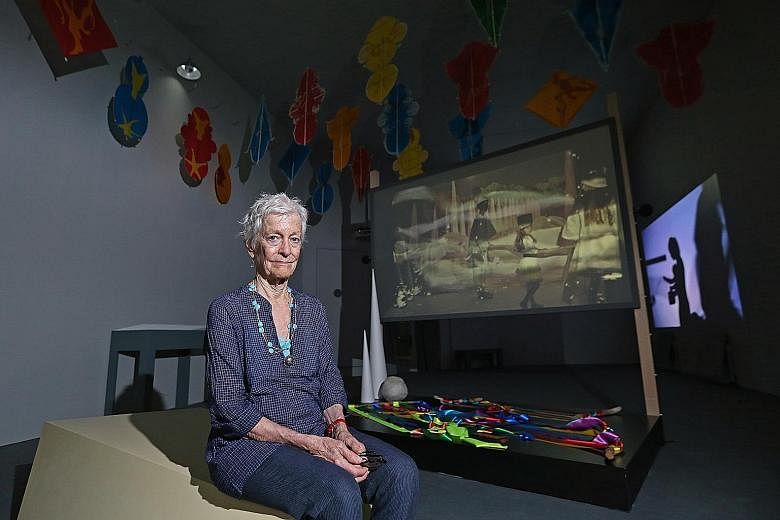The irreversible impact of human intervention on the environment is a heavy issue. But American video and performance-art pioneer Joan Jonas did not want her work addressing it to be sad.
"I do not think we have to make people sad to get them to think about these things," says the 79-year-old.
They Come To Us Without A Word, which received a prestigious Special Mention at the 56th Venice Biennale last year, is a layered multimedia installation that unfolds in interconnected rooms at the NTU Centre for Contemporary Art (CCA) Singapore's exhibition space in Gillman Barracks. This is Jonas' first major exhibition in South-east Asia, curated by Mr Paul C. Ha, director of MIT List Visual Arts Center, and Professor Ute Meta Bauer, founding director of the CCA.
In the first of many videos projected on large screens, a group of children aged five to 16 wear papier-mache masks or white paper hats and perform dances and skits. As visitors walk through the show, they see them reappear in various forms, sometimes appearing against Jonas' images of honeycombs and horses. Some of the videos feature recitations of ghost stories and speak of things that we are losing - all quietly hinting of looming ecological changes.
-
VIEW IT / THEY COME TO US WITHOUT A WORD BY JOAN JONAS
-
WHERE: NTU Centre for Contemporary Art Singapore, Block 43 Malan Road, Gillman Barracks
WHEN: Till April 3, noon to 7pm (Tuesday to Thursday, Saturday and Sunday), noon to 9pm (Friday), closed on Monday
ADMISSION: Free
INFO: Call 6339-6503 or go tontu.ccasingapore.org
Using children as the entry point into a work that takes on heavy issues makes the exhibition accessible to viewers of all ages. The underlying theme evokes the fragility of nature in a rapidly changing world.
Besides the videos, there are hand-painted drawings, a room full of mirrored reflections and beautiful handmade kites from Japan.
When asked about the eclectic mix of materials and children as the prime drivers of her narrative, the warm and genial artist tells The Straits Times: "I am interested in layered narratives. I wanted to continue experimenting with visual ideas, new ways of working with the video image and new ways of making drawings."
Jonas, a pioneer in the performance-art movement in the late 1960s, has long used video, performance, installation, sound, text and drawing.
"I did use children in some of my early performances and thought of bringing them back for this work. I was surprised by how easily they reacted to the ideas I was dealing with. We did workshops before the filming, then I left it to them to express it their way," says the acclaimed multimedia artist, who is a Professor Emerita at the Massachusetts Institute of Technology's School of Architecture and Planning.
The children are seen performing against video backdrops of her earlier works, including dramatic landscapes in Nova Scotia, Canada, and Brooklyn, New York. Jonas' voiceover picks up several stories dealing with nature, such as fragments of ghost stories sourced from an oral tradition in Cape Breton, Nova Scotia.
They Come To Us Without A Word evolved from an earlier work, Reanimation, which drew on the poetic portrayals of the natural world found in the writings of Icelandic author Halldor Laxness.
The most dramatic part is her room full of mirrors. Crystal beads appear suspended from chandeliers and several honeycombs are hand-painted on various mirrors.
Jonas calls this "a space for reflection", before the viewer walks into the final part of the installation.
"I did mirror performances at the start of my career and they have been a big part of my art. Mirrors interest me greatly. They are a constant psychological presence, visually add to a space and, sometimes, also make it challenging."
The installation ends on a dramatically colourful note. In the last room, a visitor encounters a space filled with stunning handmade kites from Japan, suspended from the ceiling and lending a certain optimism to the piece.
Co-curator Bauer says the use of handmade kites shows that "while her work uses a lot of technology, she is also interested in the disappearance of crafts - she celebrates the handmade in much of her art".
Indeed, Jonas says: "Technology should aid the art. It should not dominate."


